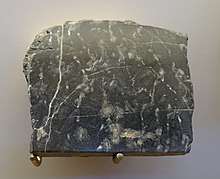Gunflint chert

The Gunflint chert (1.88 Ga[1]) is a sequence of banded iron formation rocks that are exposed in the Gunflint Range of northern Minnesota and northwestern Ontario along the north shore of Lake Superior. The black layers in the sequence contain microfossils that are 1.9 to 2.3 billion years in age. Stromatolite colonies of cyanobacteria that have converted to jasper are found in Ontario. The banded ironstone formation consists of alternating strata of iron oxide-rich layers interbedded with silica-rich zones. The iron oxides are typically hematite or magnetite with ilmenite, while the silicates are predominantly cryptocrystalline quartz as chert or jasper, along with some minor silicate minerals.
Stanley A. Tyler examined the area in 1953 and noted the red-colored stromatolites. He also sampled a jet-black chert layer which, when observed petrographically, revealed some lifelike small spheres, rods and filaments less than 10 micrometres in size. Elso Barghoorn, a paleobotanist at Harvard, subsequently looked at these same samples and concluded that "they were indeed structurally preserved unicellular organisms."[2] In 1965 the two scientists published their finding, and named a variety of the Gunflint flora.[3] This created an academic "stampede" to explore Precambrian microfossils from similar Proterozoic environments.
See also
References
- ↑ Fralick, P., David, D. W. and Kissin, Stephen A. (2002). "The age of the Gunflint Formation, Ontario, Canada: single zircon U–Pb age determinations". Canadian Journal of Earth Sciences. 39 (7): 1085–1091. doi:10.1139/E02-028.
- ↑ Past lives: Chronicles of Canadian Paleontology "Archived copy". Archived from the original on 2005-06-12. Retrieved 2005-06-12.
- ↑ Barghoorn, E. S. and Tyler, S. A., 1965: Microorganisms from the Gunflint Chert. Science, vol. 147, p. 563–577.
- Schopf, J.W., 1999: Cradle of Life: The Discovery of Earth's Earliest Fossils. Princeton University Press, 336 p. ISBN 0-691-00230-4
- Superior type Banded Iron Formation